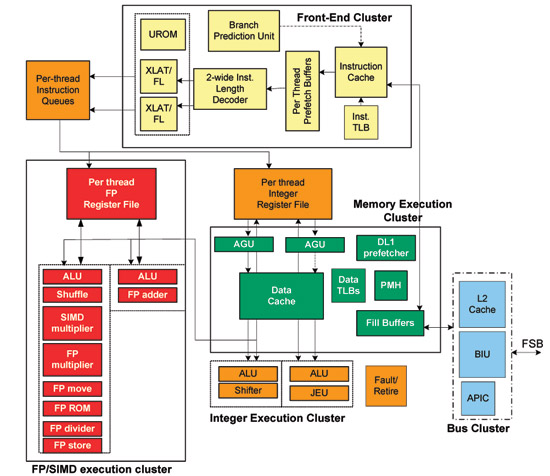NVIDIA Introduces dual Cortex A9 based Tegra 2
by Anand Lal Shimpi on January 7, 2010 2:00 PM EST- Posted in
- Smartphones
- Mobile
Atom vs. Cortex A9
With Atom Intel adopted an in-order architecture to save power. With Cortex A9, ARM went out of order to improve performance. Despite the fundamental difference, Atom and ARM's Cortex A9 appear similar from a high level.
Atom has two instruction decoders at the front end, as does the A9. The dual decoders feed an instruction queue that can dispatch out of order:

Intel's Atom Architecture
Both architectures appear to have a unified instruction queue that feed four dispatch ports. Atom has two ports that feed AGUs and/or ALUs, and two ports for the FPU (one for SSE and one for FP ops). A9 has two ALU ports, one FPU/NEON port and one AGU port.

Single-core ARM Cortex A9
Atom's advantage here is Hyper Threading as two threads get to share its execution resources simultaneously. Cortex A9's advantage is in a shallower pipeline and out of order execution. Both promote higher IPC but go about it in very different ways. If ARM can get clock speeds high enough they may actually have a higher performance option.
Final Words
Honestly, Tegra 2 is one of the most exciting things I've seen at CES - but it's mostly because of its dual Cortex A9 cores. While I'm excited about improving 3D graphics performance on tablets and smartphones, I believe general purpose performance needs improvement. ARM's Cortex A9 provides that improvement.
The days of me pestering smartphone vendors to drop ARM11 and embrace Cortex A8 are over. It's all about A9 now. NVIDIA delivers one solution with Tegra 2, but TI's OMAP 4 will also ship with a pair of A9s.
The big unknown continues to be actual, comparable power consumption. We're also lacking measurable graphics performance compared to the PowerVR SGX cores (particularly the SGX 540).
If NVIDIA is to be believed, then Tegra 2 is the SoC to get. I suspect that's being somewhat optimistic. But rest assured that if you're buying a smartphone in 2010, it's not Snapdragon that you want but something based on Cortex A9. NVIDIA is a viable option there and we'll have to wait until Mobile World Congress next month to see if there are any promising designs based on Tegra 2.
And just in case I wasn't clear earlier, we will see the first Tegra based Android phone in 2010. I just hope it's good.










55 Comments
View All Comments
altarity - Thursday, January 7, 2010 - link
Guess it's a love hate situation. I kinda like the idea of the boxee being subsumed by my bedroom dresser....sprockkets - Friday, January 8, 2010 - link
It would just take up too much space in an a/v cabinet.altarity - Thursday, January 7, 2010 - link
Maybe that's what the Boxee Box will be running....ET - Thursday, January 7, 2010 - link
Quake 3 yet again. Yawn. I know it's probably the only 3D game available, but I'm still waiting to see WoW and Sims 3 running on a Tegra. Then I'll know the PC is dead.jconan - Friday, January 8, 2010 - link
but with the new DS2 or whatever it will be called, there will be next gen 3d games...Fox5 - Friday, January 8, 2010 - link
It's rather sad, Quake 3 has been used to demo 3d pda/phone/other tiny device capabilities since the MBX Lite.Seriously, when will phones/mini-computers finally move beyond the level of dreamcast?
jensend - Thursday, January 7, 2010 - link
You won't see WoW and Sims running on a Tegra for a good long while, as those are DirectX based and thus stuck with Windows and x86. Q3 keeps getting shown off on mobile because it uses OpenGL and its code is open so people don't have to do messy licensing stuff to be able to port it to other architectures.sprockkets - Thursday, January 7, 2010 - link
So how does WoW run on OSX since it has no DirectX?From what I understand taking DirectX and making it OpenGL or equiv. isn't that hard. There just has to be a compelling reason to do it (ie money).
Affectionate-Bed-980 - Thursday, January 7, 2010 - link
x86 buddy. x86. You obviously don't know what that means.casmith - Friday, January 8, 2010 - link
Minimum: PowerPC G5 1.6 GHz or Intel Core Duo processorWhat does x86 have to do with it, again?